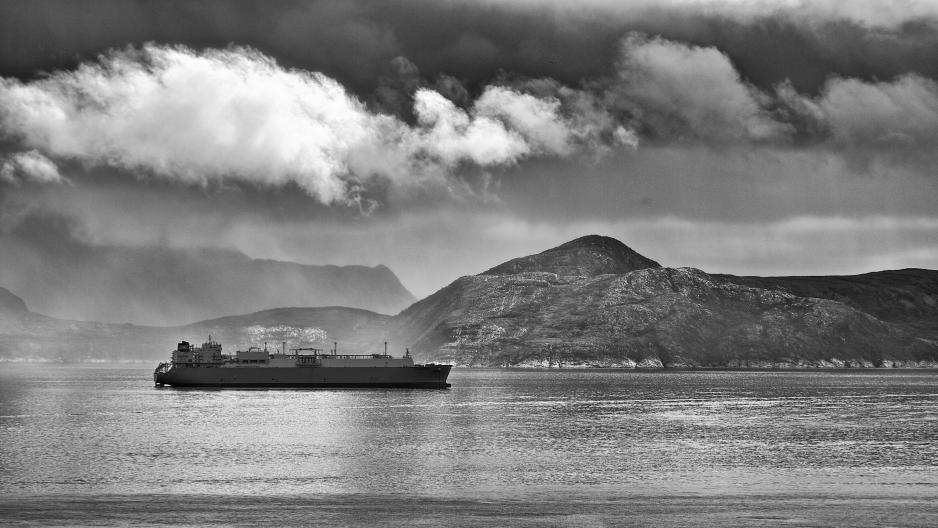Proposed Arctic Heavy Fuel Oil Ban Ineffective New Study Warns

LNG carrier of Norway's Northern Coast (Courtesy: Torbein Rønning under CC BY-NC-ND 2.0 on Flickr.com)
Just three months before the International Maritime Organization will finalize a ban on the carriage and use of heavy fuel oil in the Arctic, new research suggests that the proposed regulation would be highly ineffective at reducing heavy fuel oil use and Black Carbon emissions in the Arctic.
In an effort to protect Arctic waters from the harmful effects of heavy fuel oil (HFO) the International Maritime Organization (IMO) and its member states have been working on a ban of HFO for more than a decade.
Now researchers warn that the draft regulation for the Arctic contains too many exceptions and waivers which would exempt most ships from the new regulation until 2029.
“The IMO’s proposed HFO ban contains so many loopholes that it’s no ban at all,” the new study by the International Council on Clean Transportation, an independent nonprofit organization, concludes.
Heavy fuel oil is the cheapest and dirtiest type of marine fuel resulting in harmful Black Carbon emissions and posing a serious risk to the marine environment in the event of a spill. Its use has been banned for all vessels without exceptions in the waters surrounding Antarctica for almost a decade.
It’s well beyond time that the Arctic receives the same protection as Antarctica.
The proposed ban comes at a time when the use of HFO and Black Carbon emissions in the Arctic have increased at a worrying pace, researchers say. Between 2015 and 2019 HFO use increased by 75% and Black Carbon emissions from HFO grew by 72%. More than 700 vessels using HFO as fuel traveled throughout the Arctic carrying more 500,000 tons of HFO as fuel.
In its currently proposed form the ban would only cover a small fraction of vessels traveling in the Arctic and reduce the use of HFO by only 16% and Black Carbon emissions by only 5%.
“The IMO’s proposed HFO ban is nothing of the sort. As written, it bans less than one-third of HFO carried and less than one-sixth of HFO used by ships in the Arctic,” explains Dr. Bryan Comer, senior marine researcher at the International Council on Clean Transportation.
Too many exemptions and waivers
Earlier this year the IMO’s subcommittee on the Prevention and Response to Pollution had agreed on a draft text proposing a ban on the use and transport of HFO to take effect by mid-2024. At the time environmental groups criticized a number of loopholes, including that vessels flying the flag of Arctic coastal states would be exempt until 2029 under certain conditions.
However, it wasn’t fully understood until now just how ineffective the proposed regulation would be at curtailing the carriage and use of HFO and black carbon emissions.
The draft regulation allows for exemptions and waivers for certain vessels in internal waters, territorial seas and the Exclusive Economic Zones of the Arctic coastal states.
Ships that separate their fuel tanks from their outer hull by at least 76 centimeters can continue to use HFO as fuel until mid-2029. In addition, vessels flagged to the five Arctic coast states – Russia, Canda, the U.S., Denmark, and Norway – can choose to exempt their vessels when operating in their waters. Together these loopholes would allow almost 75% of vessels that operated in the Arctic in 2019 to continue using HFO.
Time to protect the Arctic
The researchers highlight the urgent need to protect the Arctic marine environment.
“HFO has already been banned in the Antarctic since 2011, without exemptions or waivers. It’s well beyond time that the Arctic receives the same protections,” urges Comer.
A number of recent shipping accidents, including the spill of 1,000 tons of HFO when the Wakashio bulk carrier broke apart off the coast of Mauritius last month, highlight the need for action.
Thus far the Arctic Ocean has escaped a large-scale spill but has come dangerously close on several occasions. In 2017, Danish bulk carrier Nordic Barents collided with the nuclear icebreaker Vaygach fortunately not resulting in any spill. In 2013 the tanker Nordvik was struck by ice and started to take on water before the crew was able to stop the ingress and in July 2010 two fully-laden Russian oil tankers, the Indiga and the Varzuga, collided in medium ice conditions and poor visibility.
Russian opposition to stronger regulations
The study calls for fewer exemptions and waivers or at least to more clearly specify where waivers can be issued. In total the study suggests and evaluates six alternatives on how to strengthen the currently-proposed ban.
“IMO member states should at the very least clarify where waivers may be issued. The current text is so vague that it could allow Arctic countries to grant waivers inside their entire Exclusive Economic Zone [extending 200 nautical miles from shore],” says Comer.
If waivers were to be limited to internal and territorial waters – 12 nautical miles – the use of HFO could be reduced by a factor of two.
It is unlikely that Russia will agree to such a change as it was the lone Arctic state opposing a HFO ban and only conceded after it secured the aforementioned waiver for Russian-flagged vessels within its waters.
Russian vessels traveling along the country’s Northern Sea Route (NSR) routinely violate Russian safety and navigation rules, adding even more urgency to putting in place an effective HFO ban under the auspices of the IMO.
As High North News reported, in 2017 nearly 100 ships, accounting for 20% of all Russian-flagged vessels along the NSR, violated safety rules. Russia’s Northern Sea Route Administration stopped publishing data on these violations in 2018 and has not made the data available to HNN for the years 2018-2020.


